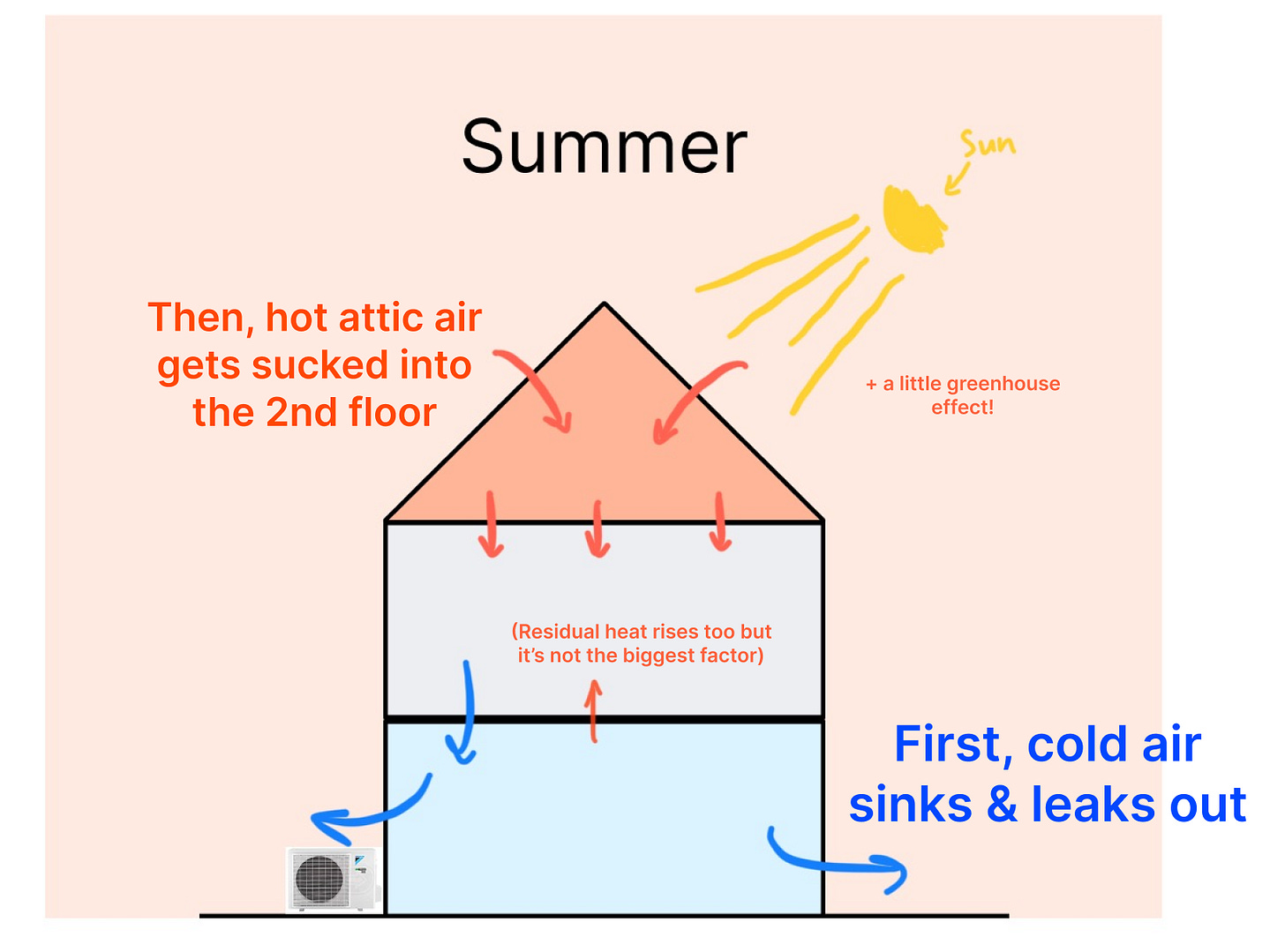Reverse Stack Effect
And why your 2nd floor tends to feel warmer in the summer, beyond just rising hot air.
We noticed in the June 2025 heat wave (hottest in 15 years!) that a number of the heat pumps we installed, particular with ducted attic systems conditioning the 2nd floor, struggled to maintain 70 degrees when it’s 90°F+ out.
Why was that? Well, among many other reasons1, we thought it may have something to do with heat naturally rising to the top of a house.
We reached out to Amply co-founder (& building science expert) Eric Fitz to get his take on it. To our surprise, the 2nd floors get hotter not only due to hot air rising/cold air sinking, but also due to hot air from the outside & attic pushing down/getting “sucked” down into the 2nd floor.
Here’s a closeup:
Eric’s Take
The stack effect is reversed in summer but is significantly diminished compared to winter. The "heat rises" explanation is not a technically correct way to describe the issue in summer.
The pressure gradient in the summer conditions creates infiltration on the upper stories of a home and exfiltration on lower stories. So it is more about hot air being "pushed into" the house via the attic and upper-story cracks in the building.
There is often a negative feedback loop here that is driven by occupant behavior...upper stories get uncomfortable so people open the window to get air movement. This accelerates infiltration of hot air into the home / exfiltration of cold air.
Winter Effect Demonstration
Eric’s mentioned that the effect is significantly diminished vs. the winter. I’m including this video in a massive commercial building to make it easier to understand the effects:
Other Factors for Hotter Ducted 2nd Floors
Duct Losses are a Big Deal
Attic temps in particular can get crazy high if the home does not have a radiant barrier. Old homes in MA rarely have them. Things also get really bad if you have higher-than-average duct leakage which most people rarely measure / verify as part of ensuring that there is sufficient duct capacity.
(Side note: this is why we do ductwork performance testing.)
Solar Gain (aka the sun shining on the house)
Solar gain can be the biggest driver of cooling loads, not outdoor temperature, as design conditions are hit or exceeded: This is particularly true of homes in MA that often have old single-pane, clear (non LowE) windows that have solar heat gain coefficients (SHGC) of nearly 100%.
Can confirm, by the way, that attics get super hot when the sun is shining on it during a hot summer day. The ceiling of this attic is about 120°F!
SEER Ratings & Duct Losses
Duct losses are indeed the primary reason why ducted systems have a lower SEER rating relative to ductless: See equation 11.4 on p. 41 of AHRI Standard 210/240 that is used for testing equipment. Duct losses are partially simulated in the lab... but you can see that the primary driver of losses is the difference between indoor and outdoor temperatures. There are still losses in a ductless system (i.e. in the refrigerant lines between the outdoor and indoor units) but they are tiny compared to a ducted system.
Equipment derates due to outdoor temp
Just like at cold temp extremes, heat pumps (or standard AC units) have lower capacity at extreme high outdoor temps. This can vary quite dramatically from manufacturer to manufacturer or even within particular OEMs product line.
For example, a Dakin Fit "3.5 ton" has nearly 100% rated capacity at 100F but a Daikin Fit "5 ton" cooling capacity drops pretty quickly towards only 48k as you exceed 100F outdoor.
TL;DR you need to look at Manual S to get the full story of what is going on in these homes.
What temperature should we expect to keep?
Yes, best practice is to use indoor design temp of 75F for the cooling season.
(This was in response to me bringing up an observation that the Manual J recommends 75 degrees as a design set point.)
Takeaways
We’re going to start telling everyone to expect the system to be able to cool down to 75, but not the low 70s. We’ll upsize the attic system if we need to do that & choose a condenser with a great turndown ratio to account for it.
Separately, as we wrote about in our performance article, we’re going to recommend ductless mini-split wall units for people who really care about discharge temp during a heat wave. I’m starting to think they’re the best option2 for efficiency & comfort, as long as the outdoor unit has a good enough turndown ratio.
Read the 3rd section of the heat wave article to find out!
Plus, they’re less expensive b/c you don’t need to climb into a hot attic to install it!





